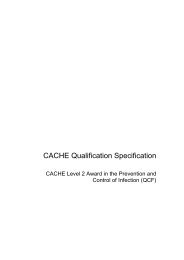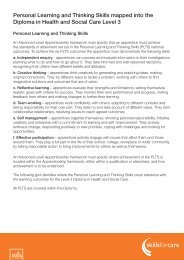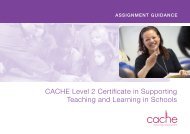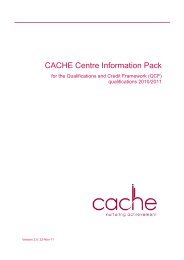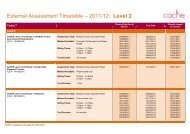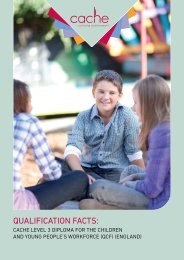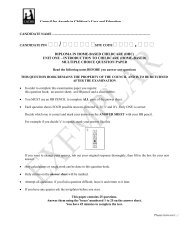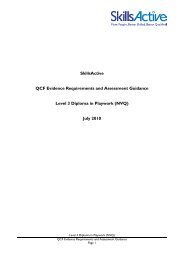EXEMPLAR PAPER 1 - Cache
EXEMPLAR PAPER 1 - Cache
EXEMPLAR PAPER 1 - Cache
Create successful ePaper yourself
Turn your PDF publications into a flip-book with our unique Google optimized e-Paper software.
Council for Awards in Children’s Care and Education<br />
CANDIDATE NAME …………………………………………………………………………………………<br />
CANDIDATE PIN / SITE CODE . <br />
CACHE LEVEL 2 CERTIFICATE IN CHILD CARE AND EDUCATION – CCCE L2<br />
Unit 3 – Safe, healthy and nurturing environments for children<br />
MULTIPLE CHOICE QUESTION <strong>PAPER</strong><br />
<strong>EXEMPLAR</strong> <strong>PAPER</strong> 1<br />
Read the following notes BEFORE you answer any questions<br />
THIS QUESTION BOOK REMAINS THE PROPERTY OF THE COUNCIL AND IS TO BE RETURNED<br />
AFTER THE EXAMINATION<br />
• In order to complete this examination paper you require:<br />
this question book; an answer sheet; an HB pencil and a clean rubber.<br />
• You MUST use an HB PENCIL to complete ALL parts of the answer sheet.<br />
• Each question shows FOUR possible answers (lettered 'a', 'b', 'c' and 'd'). Only ONE is correct.<br />
Decide which one is correct and mark your answer on the ANSWER SHEET with your HB pencil.<br />
For example if you decide 'c' is correct, mark your answer like this<br />
1 ⊂ a ⊃<br />
⊂ b ⊃<br />
⊂ c ⊃<br />
⊂ d ⊃<br />
If you want to change your answer, rub out your original response thoroughly, then fill in the box for your new<br />
answer.<br />
• Any calculations or rough work can be done in this question book.<br />
• Only entries on the answer sheet will be marked.<br />
• Attempt all questions; if you find a question difficult, leave it and return to it later.<br />
• If you have any queries ask the invigilator before you start.<br />
Please turn over.../<br />
This paper contains 25 questions.<br />
Answer them using the 'boxes' numbered 1 to 25 on the answer sheet.<br />
You have 45 minutes to complete the test.<br />
© CACHE CCCE-L2 Exemplar Paper 1
1 Which policy should practitioners<br />
follow to avoid personal accidents or<br />
injuries<br />
5 The Safeguarding Children policy<br />
informs practitioners how to protect<br />
children from<br />
a<br />
b<br />
c<br />
d<br />
Settling-in policy<br />
Health and Safety policy<br />
Safeguarding Children policy<br />
Equality of Opportunities policy<br />
a<br />
b<br />
c<br />
d<br />
obesity<br />
bullying<br />
discrimination<br />
cross-infection<br />
2 The Safeguarding Children policy of a<br />
setting informs staff about how to help<br />
children to<br />
a<br />
b<br />
c<br />
d<br />
be protected<br />
keep healthy<br />
enjoy learning<br />
form friendships<br />
3 Before an outing, practitioners should<br />
complete a risk assessment to make<br />
sure that<br />
a<br />
b<br />
c<br />
d<br />
hazards are identified<br />
parent helpers know what to do<br />
children know where they are<br />
going<br />
children will be able to rest or<br />
sleep<br />
4 The Health and Safety policy BEST<br />
supports children's needs for<br />
6 The BEST way to make sure new<br />
play equipment is safe to use is to<br />
a<br />
b<br />
c<br />
d<br />
clean the equipment<br />
thoroughly<br />
attend health and safety<br />
training<br />
follow the manufacturer's<br />
instructions<br />
let the older children play on it<br />
first<br />
7 How can practitioners keep children<br />
safe at the end of the session<br />
a<br />
b<br />
c<br />
d<br />
help them to put on their coats<br />
observe them during the<br />
home-time routine<br />
encourage them to take home<br />
their paintings<br />
make sure they are collected<br />
by a named adult<br />
a<br />
b<br />
c<br />
d<br />
development<br />
personal care<br />
special education<br />
play and learning<br />
8 All visitors to the setting MUST<br />
a sign in and sign out<br />
b have had a CRB check<br />
c remove outdoor clothes<br />
d know one of the children<br />
© CACHE CCCE-L2 Exemplar Paper 1
9 When completing a risk assessment<br />
of a piece of large equipment, the<br />
practitioner MUST<br />
a<br />
b<br />
c<br />
d<br />
identify any staff training needs<br />
ask for opinions from<br />
colleagues<br />
read reports of any previous<br />
accidents<br />
decide how many adults<br />
should supervise the children<br />
13 Practitioners can help to protect<br />
themselves from allegations of<br />
unprofessional behaviour in the<br />
setting by<br />
a<br />
b<br />
c<br />
d<br />
staying calm in all situations<br />
making families feel welcome<br />
following the policies and<br />
procedures<br />
asking their supervisor for<br />
instructions<br />
10 The MOST important reason to keep<br />
observations and personal records<br />
confidential is to<br />
a<br />
b<br />
c<br />
d<br />
promote children's<br />
independence<br />
provide information for parents<br />
protect children and families<br />
maintain a safe environment<br />
14 Practitioners can keep children<br />
safe by<br />
a<br />
b<br />
c<br />
d<br />
attending training courses<br />
using child protection<br />
procedures<br />
building relationships with<br />
families<br />
involving carers in positive<br />
parenting<br />
11 The BEST way to keep a baby safe in<br />
a pushchair is to<br />
a<br />
b<br />
c<br />
d<br />
use a waterproof cover<br />
attach a sun shade<br />
clean the seat regularly<br />
check the harness lock<br />
12 A child aged 5 years starts to talk<br />
about something that happened at<br />
home which concerns the practitioner.<br />
What should the practitioner do<br />
FIRST<br />
a<br />
b<br />
c<br />
d<br />
question the child<br />
inform the manager<br />
listen to the child<br />
read the safeguarding policy<br />
15 How can a practitioner work safely<br />
when dealing with an aggressive<br />
parent<br />
a<br />
b<br />
c<br />
d<br />
avoid talking to the parent<br />
attend staff training sessions<br />
have another practitioner<br />
present<br />
keep a written record of the<br />
meeting with the parent<br />
16 To protect themselves from<br />
accusations of inappropriate<br />
behaviour, practitioners should<br />
always<br />
a<br />
b<br />
c<br />
d<br />
dress in suitable clothes<br />
involve parents in daily routines<br />
work closely with their<br />
managers<br />
work where other colleagues<br />
can see them<br />
© CACHE CCCE-L2 Exemplar Paper 1
17 To prevent injury to themselves<br />
when setting out large play equipment<br />
indoors, practitioners should<br />
21 A child aged 3 years kicks another<br />
child. What should the practitioner<br />
do FIRST<br />
a<br />
b<br />
c<br />
d<br />
wash the floor in preparation<br />
bend their knees when lifting<br />
wear gloves when moving mats<br />
check what equipment is<br />
needed<br />
a<br />
b<br />
c<br />
d<br />
record the kicking incident<br />
tell the parents of both children<br />
comfort the child who was<br />
kicked<br />
ask the child who kicked to<br />
apologise<br />
18 Children aged 7 years are MOST<br />
likely to lack self-confidence if they<br />
a<br />
b<br />
c<br />
d<br />
are able to read<br />
are being bullied<br />
have a best friend<br />
have a younger sibling<br />
19 A child aged 4 years is MOST likely to<br />
become frustrated when<br />
22 What is the BEST way to manage<br />
unwanted behaviour in a child<br />
aged 2 years<br />
a<br />
b<br />
c<br />
d<br />
praise any desirable behaviour<br />
ask the parent to stay with the<br />
child<br />
explain why the behaviour is<br />
unwanted<br />
record the behaviour on a star<br />
chart<br />
a<br />
b<br />
c<br />
d<br />
an activity is too difficult<br />
a new activity is set out<br />
there is a choice of activities<br />
practitioners join in activities<br />
23 Practitioners need to understand<br />
stages of social and emotional<br />
behaviour in order to<br />
20 Which of these is MOST likely to<br />
promote positive behaviour in children<br />
aged 6 years<br />
a<br />
b<br />
c<br />
d<br />
being well nourished<br />
sharing a favourite toy<br />
having an extended family<br />
knowing they are listened to<br />
a<br />
b<br />
c<br />
d<br />
maintain a safe environment<br />
reduce the risk of accidents<br />
keep children's records<br />
up-to-date<br />
respond appropriately to<br />
children's behaviour<br />
24 The BEST way to manage a child<br />
aged 3 years who has a temper<br />
tantrum is to<br />
a<br />
b<br />
c<br />
d<br />
talk calmly to the child<br />
distract the child with a toy<br />
ignore the unwanted behaviour<br />
change the child's daily routine<br />
© CACHE CCCE-L2 Exemplar Paper 1
25 Practitioners and parents should work<br />
together to support children in<br />
managing their behaviour by<br />
a<br />
b<br />
c<br />
d<br />
writing a behaviour policy<br />
providing challenging activities<br />
sharing records of children's<br />
progress<br />
having the same rules and<br />
boundaries<br />
THE END<br />
© CACHE CCCE-L2 Exemplar Paper 1
Test Specification for CACHE Level 2 Certificate in Child Care and Education<br />
CCCE-L2<br />
Multiple Choice Question – Exemplar<br />
Question<br />
Number<br />
Key<br />
1 B<br />
2 A<br />
3 A<br />
4 B<br />
5 B<br />
6 C<br />
7 D<br />
8 A<br />
9 C<br />
10 C<br />
11 D<br />
12 C<br />
13 C<br />
14 B<br />
15 C<br />
16 D<br />
17 B<br />
18 B<br />
19 A<br />
20 D<br />
21 C<br />
22 A<br />
23 D<br />
24 A<br />
25 D<br />
Number of marks achieved<br />
Grade<br />
15 or above Pass<br />
14 or below Referral
Certificate Child Care Education (CCCE – L2)<br />
Unit 3 – Safe, Healthy and Nurturing Environments For Children<br />
Multiple Choice Question Paper<br />
Exemplar Paper 2<br />
Read the following notes BEFORE you answer any questions<br />
This question book remains the property of the council and is to be returned after the examination<br />
• In order to complete this examination paper you require:<br />
this question book; an answer sheet; an HB pencil and a clean rubber.<br />
• You MUST use an HB PENCIL to complete ALL parts of the answer sheet.<br />
• Each question shows FOUR possible answers (lettered 'a', 'b', 'c' and 'd'). Only ONE is correct.<br />
Decide which one is correct and mark your answer on the ANSWER SHEET with your HB pencil.<br />
For example if you decide 'c' is correct, mark your answer like this<br />
If you want to change your answer, rub out your original response thoroughly, then fill in the box for<br />
your new answer.<br />
• Any calculations or rough work can be done in this question book.<br />
• Only entries on the answer sheet will be marked.<br />
• Attempt all questions; if you find a question difficult, leave it and return to it later.<br />
• If you have any queries ask the invigilator before you start.<br />
This paper contains 25 questions.<br />
Answer them using the 'boxes' numbered 1 to 25 on the answer sheet.<br />
You have 45 minutes to complete the test.<br />
Please turn over.../<br />
© CACHE 1 CCCE L2 Exemplar Paper 2
1 When completing a risk assessment the<br />
practitioner should refer to the setting's<br />
a<br />
b<br />
c<br />
d<br />
Data Protection policy<br />
Health and Safety policy<br />
Safeguarding Children policy<br />
Behaviour Management policy<br />
6 When setting up new equipment, the<br />
practitioner should follow the<br />
manufacturer's guidelines in order to<br />
a<br />
b<br />
c<br />
d<br />
keep the equipment clean<br />
store the equipment correctly<br />
make the equipment last longer<br />
make sure the equipment is safe<br />
2 Which policy in an early years group<br />
setting will refer to bullying<br />
a<br />
b<br />
c<br />
d<br />
Inclusion policy<br />
Settling-in policy<br />
Health and Safety policy<br />
Safeguarding Children policy<br />
3 Children aged 7 years are MOST<br />
likely to be safe during an outing<br />
when practitioners<br />
a<br />
b<br />
c<br />
d<br />
ask parents to help plan an outing<br />
have written consent for the<br />
outing<br />
supervise the children closely<br />
during an outing<br />
involve children when choosing<br />
the venue for the outing<br />
7 During a fire evacuation procedure,<br />
practitioners should FIRST<br />
a<br />
b<br />
c<br />
d<br />
lock all the windows<br />
help children to put on their coats<br />
take children out of the building<br />
collect children's personal<br />
belongings<br />
8 The FIRST action for a practitioner after<br />
completing a risk assessment is to<br />
a<br />
b<br />
c<br />
d<br />
write a detailed report<br />
remove any unsafe equipment<br />
check the rota for parent helpers<br />
read the Health and Safety<br />
procedures<br />
4 A Safeguarding Children policy will<br />
provide information about<br />
a<br />
b<br />
c<br />
d<br />
safe working practices<br />
achievement and learning<br />
a challenging environment<br />
healthy snacks and meals<br />
5 To meet the requirements of legislation,<br />
it is important that settings use toys and<br />
equipment that<br />
a<br />
b<br />
c<br />
d<br />
are suitable for purpose<br />
can be used independently<br />
are clean and easy to maintain<br />
can be moved to different areas in<br />
the setting<br />
9 Carrying out risk assessments in a<br />
setting will<br />
a<br />
b<br />
c<br />
d<br />
help plan suitable activities<br />
reduce the cost of safety<br />
equipment<br />
identify hazards which could harm<br />
a child<br />
make sure children have space to<br />
play<br />
10 When babies are sleeping in the setting<br />
the BEST way to keep them safe is to<br />
a<br />
b<br />
c<br />
d<br />
play calm music<br />
provide comforters<br />
supervise frequently<br />
use sheets and blankets<br />
© CACHE 2 CCCE L2 Exemplar Paper 2
11 Practitioners can support children in<br />
keeping themselves safe by<br />
16 How can a practitioner work safely when<br />
dealing with an aggressive parent<br />
a<br />
b<br />
c<br />
d<br />
valuing their different cultures<br />
observing their growth and<br />
development<br />
providing activities which<br />
challenge them<br />
developing their confidence and<br />
self-esteem<br />
a<br />
b<br />
c<br />
d<br />
avoid talking to the parent<br />
attend staff training sessions<br />
have another practitioner present<br />
keep a written record of the<br />
meeting with the parent<br />
12 A practitioner who gives information to<br />
others in the setting should<br />
17 Practitioners should help to keep<br />
themselves safe from allegations of<br />
abuse by following safe working<br />
practices for<br />
a<br />
b<br />
c<br />
d<br />
maintain confidentiality<br />
give a personal opinion<br />
complete a detailed record<br />
tell everyone at a staff meeting<br />
a<br />
b<br />
c<br />
d<br />
giving first aid<br />
safeguarding children<br />
maintaining food hygiene<br />
implementing the early years<br />
curriculum<br />
13 Practitioners can BEST help to keep<br />
children safe from abuse or neglect by<br />
a<br />
b<br />
c<br />
d<br />
observing all children carefully<br />
asking advice from a supervisor<br />
writing a policy at a staff meeting<br />
discussing individual children with<br />
colleagues<br />
18 How can practitioners BEST promote<br />
positive behaviour in young children<br />
a<br />
b<br />
c<br />
d<br />
observe the children<br />
work with the parents<br />
be a good role model<br />
have the same expectations of all<br />
children<br />
14 Which policy should practitioners follow to<br />
keep themselves safe from allegations of<br />
child abuse<br />
a<br />
b<br />
c<br />
d<br />
Health and Safety policy<br />
Behaviour Management policy<br />
Safeguarding Children policy<br />
Special Educational Needs policy<br />
19 Children aged 3 years are MOST likely to<br />
show attention-seeking behaviour<br />
when they<br />
a<br />
b<br />
c<br />
d<br />
visit a relative<br />
play with a friend<br />
share a book with an adult<br />
have a new sibling in the family<br />
15 To keep themselves safe in the setting,<br />
practitioners should<br />
a<br />
b<br />
c<br />
d<br />
attend training courses<br />
follow the setting's policies<br />
understand children's<br />
development<br />
communicate well with colleagues<br />
© CACHE 3 CCCE L2 Exemplar Paper 2
20 Which action is MOST likely to<br />
promote positive behaviour in children<br />
aged 4 years<br />
a<br />
b<br />
c<br />
d<br />
asking children to play quietly<br />
sitting children in a circle at story<br />
time<br />
encouraging children to tidy up<br />
after play<br />
giving children time to complete<br />
activities<br />
21 The BEST way to manage the behaviour<br />
of children aged 6 to 7 years is to<br />
a<br />
b<br />
c<br />
d<br />
explain the consequences of their<br />
actions<br />
make sure that they always help<br />
each other<br />
tell parents about any unwanted<br />
behaviour<br />
provide them with the same<br />
activities regularly<br />
24 Children aged 5 years should be involved<br />
in making rules to help them manage<br />
their behaviour. These rules should be<br />
a<br />
b<br />
c<br />
d<br />
given to parents to read<br />
easy for all adults to remember<br />
simple for children to understand<br />
displayed on posters in the setting<br />
25 Involving children aged 7 years in<br />
developing rules for behaviour in the<br />
setting will BEST help<br />
a<br />
b<br />
c<br />
d<br />
children to complete a new task<br />
children to understand adult's<br />
expectations<br />
practitioners to meet children's<br />
individual needs<br />
practitioners to review procedures<br />
for promoting equality of<br />
opportunities<br />
22 A child aged 3 years shows challenging<br />
behaviour when a visitor comes into the<br />
setting. What should the practitioner do<br />
THE END<br />
a<br />
b<br />
c<br />
d<br />
stay with the child<br />
ask the visitor to leave<br />
try to distract the child<br />
tell the child the visitor's name<br />
23 What is the MOST effective strategy<br />
to manage conflict between children<br />
aged 2 years<br />
a<br />
b<br />
c<br />
d<br />
talk to the children<br />
distract the children<br />
supervise the children closely<br />
ask the children's parents for<br />
advice<br />
© CACHE 4 CCCE L2 Exemplar Paper 2
Answer Key for CACHE Level 2 Certificate in Child Care and Education<br />
CCCE-L2<br />
Multiple Choice Question – Exemplar Paper 2<br />
Question<br />
Number<br />
Key<br />
1 B<br />
2 D<br />
3 C<br />
4 A<br />
5 A<br />
6 D<br />
7 C<br />
8 B<br />
9 C<br />
10 C<br />
11 D<br />
12 A<br />
13 A<br />
14 C<br />
15 B<br />
16 C<br />
17 B<br />
18 C<br />
19 D<br />
20 D<br />
21 A<br />
22 A<br />
23 B<br />
24 C<br />
25 B<br />
Number of marks achieved<br />
Grade<br />
15 or above Pass<br />
14 or below Referral



